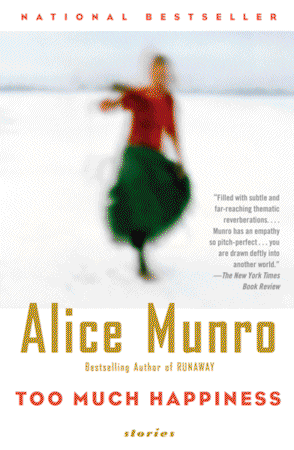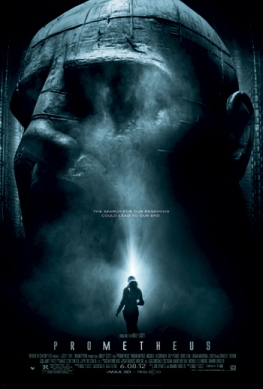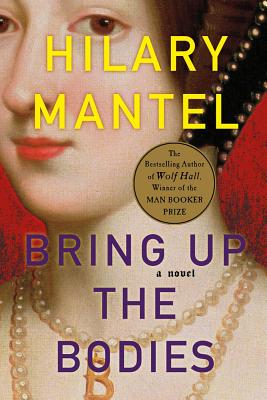Subscribe by Email
-
Recent Posts
Monthly Archives: June 2012
Too Much Happiness

Shortly after marrying a Canadian and becoming a Canadian resident, my sister-in-law thrust a book into my hands by Alice Munro, one of her favorite authors. I had known about Munro, the acclaimed Canadian writer who had won many awards for her short stories (including the 2009 Man Booker International Prize), but I am embarrassed to say before now I had not read any of her collections. Her stories were often in the New Yorker and I might have read her there, but I knew living in Canada that her books would be essential reading for my own cultural introduction to my new country.
Her short-story collection “Too Much Happiness, ” which is her most recent from 2009, didn’t disappoint but rather exceeded my expectations from the praise that preceded her. I guess I don’t often read short stories (though I have liked Raymond Carver’s, Jhumpa Lahiri’s and Somerset Maugham’s) but delving into hers were easy and absorbing, like falling into a world that sweeps you up. I was a bit surprised that this genteel author (78 years old at the time) from rural Ontario wrote about characters that drew you in so completely to such ominous or unsettling predicaments. Murderers, deviants and misfits pepper the stories of “Too Much Happiness,” which reminded me a bit of the dark aspects of Flannery O’Connor’s or Joyce Carol Oates’s stories.
In “Child’s Play,” two summer camp friends live with the repercussions of a terrible crime they commit, while in “Face,” a boy deals with the taunts from a birthmark that covers half his head. In “Deep-Holes” a family loses touch with a son involved in a cliff-falling accident, and in “Free Radicals,” an old woman saves her neck by telling a violent burglar of her own past crime. All 10 stories in “Too Much Happiness” are quite affecting; they grab at your lapels and shake you good. But perhaps the creepy “Dimensions” and “Wenlock Edge” are the collection’s most unnerving. It’s in “Dimensions” that an incident jars a wife to finally overcome her ties to her abusive jailed husband, and in “Wenlock Edge” where a student’s sexual violation steers her to turn in another.
It’s hard not to give too much away, better just to marvel at Munro’s mastery of these potent stories. Interestingly, her last story, “Too Much Happiness,” is quite a departure from the others. It’s based on a real person Sophia Kovalevsky, who was a prominent Russian mathematician in the latter 1800s, and deals with her life in the days before her death. Though interesting, I thought the other more contemporary, Canada-set stories pulled at me more. But regardless, I’m going to add Munro’s other collections to my reading list, particularly “Runaway” from 2004 and “The View From Castle Rock” from 2006. She’s definitely a writer to be treasured and one I’m so glad, no matter which side of the border, not to have missed. Continue reading
Posted in Books
2 Comments
Prometheus

I caught director Ridley Scott’s 3-D film “Prometheus” last Friday on opening night. It’s quite a visual feast as are some of his other movies such as “Black Hawk Down,” “Gladiator,” and “Thelma & Louise.” It’s his first return to sci-fi since “Blade Runner” in 1982, and a quasi-prequel to “Alien” in 1979, so I wasn’t about to miss it.
The film is a bit mysterious and I’m still gathering my thoughts over it. What is clear is that it’s about a team of scientists who are sent off into deep space on a corporate project to find clues about the origins of humankind. Their spaceship lands on a planet with some kind of large installation built on it, filled with tunnels and caves. It seems promising, but once the scientists start to poke around inside ominous things begin to happen. They find a prototype corpse and an arsenal of weapons deserted by their owners. Slithery creatures pop up and apparitions run past, what the heck are those holographic like things?! I wish they’d make a dash back to Earth, but a sample from the corpse yields a human DNA match, enticing the scientists further that it might be from our Creator. But if so, what happened at this desolate place?
I won’t give any more away, but suffice it to say, what follows after is not exactly tame or pretty. You might not want to see this movie if you’re pregnant because it pretty much outdoes the stomach scene from “Alien” and is on par with a scene from “The Fly.” “Prometheus” is a movie that starts gradual but shifts into a fast pace of destruction toward the end. Noomi Rapace, who was terrific in the Swedish version of “Girl With the Dragon Tattoo,” is quite good as the scientist, who follows a bit in the footsteps of Sigourney Weaver, the heroine who made her mark in the “Alien” series. Charlize Theron, who plays the corporate chief in this, seems a bit flat or misplaced to me, but Michael Fassbender as the deviant robot David is wonderful in his role. I still don’t trust him!
The ending of “Prometheus” leaves open various questions and plenty of room for sequels. Why for instance does the Creator seem to hate us so? I guess that’s for next time. But while the film doesn’t exactly match the classic “Alien,” it’s still a visual treat that raises thoughts about the vast universe and our origins in it. For a sci-fi summer blockbuster, it’s well worth its weight in popcorn and admission.
To read more on actress Noomi Rapace check out the NYT’s recent profile of her. Continue reading
Posted in Movies
6 Comments
Bring Up the Bodies

I coincidentally was reading Hilary Mantel’s historical novel “Bring Up the Bodies” around the same time as I was watching the “Diamond Jubilee” celebration, commemorating Queen Elizabeth II’s amazing 60 years on the throne of England. Perhaps there’s not a direct correlation, but I’m definitely getting my fix of English royal history lately, with its influential monarchs and their reigns of power, accomplishments, struggles and scandals. It’s fascinating material to be sure.
Mantel’s latest novel about Thomas Cromwell, the court of King Henry VIII and the destruction of Queen Anne Boleyn has received unanimous gushing reviews as did her previous book of their earlier years, “Wolf Hall,” which was awarded the 2009 Man Booker Prize. The print critics love her, with Janet Maslin of the New York Times going as far to say that “Bring Up the Bodies” is “this year’s best beach read” and the “one must-read of the season.”
Best beach read? Hmm, I had to read it. But now that I’m done, I can tell you, if you like “War and Peace” or Shakespeare on the beach then perhaps you will definitely like this one. Otherwise, I’d stick to something lighter and easier to sink into. “Bodies” definitely has the elements of a beach book, with power plays, intrigue, rumors, gossip, revenge, adultery, violence, but it swirls around for quite a while, muting its impact. Its narrative language though beautiful by Mantel is a bit of a challenge for the beach; it’s not Olde English but it’s not exactly contemporary either. You’ll have to work a bit to get the array of characters and who is speaking when and what is being said. At times it can be a bit confusing or even a slog to read, but I did successfully plow through it and came away with a more vivid picture of the poisonous atmosphere at the court during Anne Boleyn’s last months.
You don’t have to read its predecessor “Wolf Hall” to understand “Bring Up the Bodies”; I went right to the latter one, which is meant to be the second in a trilogy — all told from Thomas Cromwell’s point of view. Cromwell was King Henry VIII’s right hand man, his secretary and power broker, who comes to believe he must destroy the Queen before she destroys him. Mantel paints him as more human than just ruthlessly evil, which is how he is often portrayed, though he’s still cleverly shrewd and harsh in the end.
The book takes place over nine months from 1535 to 1536. As it begins, Queen Anne Boleyn has replaced King Henry VIII’s first wife Katharine of Aragon with much ado, leading the King to break with the Catholic Church in Rome. All is momentarily at peace. But after three years, the king grows restless as Anne is unable to produce a male heir and he begins to favor Jane Seymour. Thereafter the Queen’s days are numbered. Cromwell uncovers a web, eventually arresting her along with five men on trumped up charges of adultery and incest (with her brother). Whether she is actually guilty as charged is a mystery preserved in the book, though it sides with it being unlikely. In an interview, Hilary Mantel has said the Queen gives the impression of being guilty, whether or not she really is, is not known.
Surely the book is quite dark; everybody’s out for themselves and trying to gain their advantage with the King and the court. It seems Machiavellian. Some have sympathies with the last Queen, while others are aligning with the future, Jane Seymour. The plot gangs up on Anne Boleyn, and it is quite chilling to read about a woman’s place then and the abuse of the court’s power — all because Henry VIII wanted a new wife. There’s not really a redeeming character in the book to latch onto, and despite what it’s about, not a lot of action. I was hoping for more. It’s mostly filled with the verbal sparring, court gossip and posturing amid its unseemingly cast. I took away quite a bit from it but not without considerable persistence and effort — something that I don’t hope for in my next (real) beach read. Continue reading
Posted in Books
9 Comments
